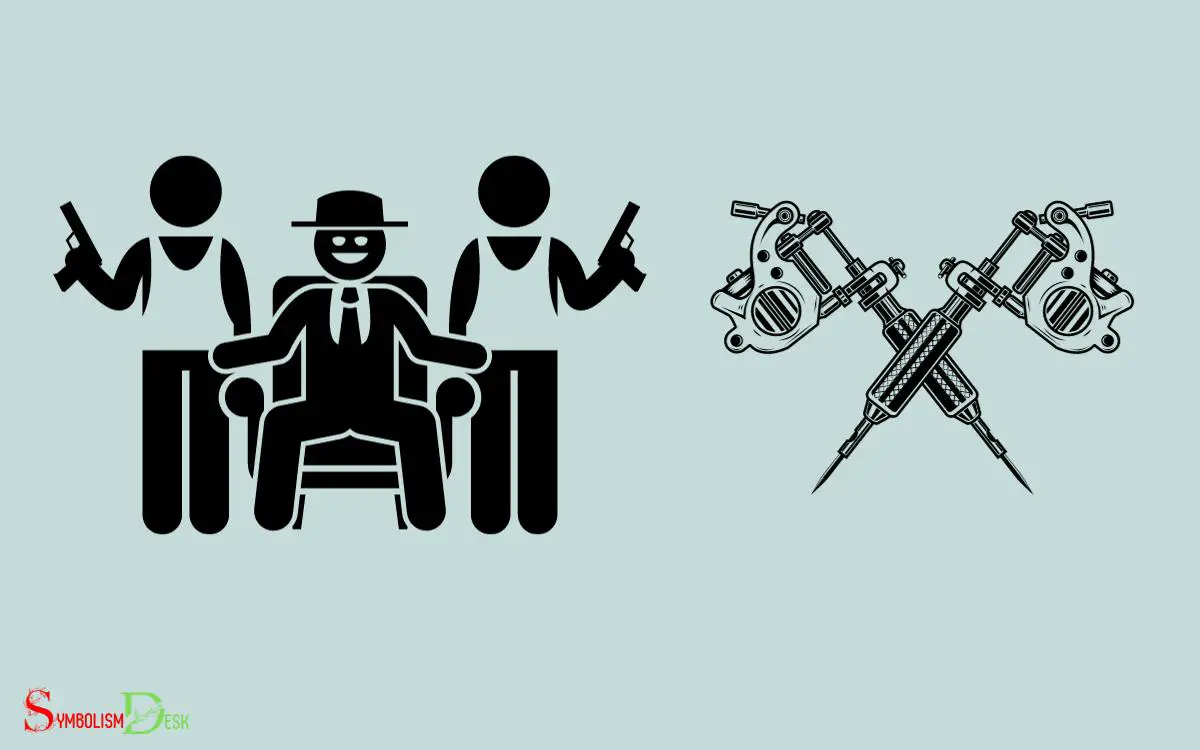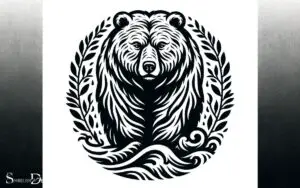Gang Tattoo Symbols and Meanings: Loyalty!
Gang tattoos are intricate symbols that often signify a member’s loyalty, achievements, and experiences within the gang. These tattoos are not just body art but are encrypted emblems with specific meanings known to insiders.
Some common gang tattoo symbols include teardrops, which can represent the loss of a fellow member or a kill, spider webs that might signify time spent in prison, and crowns that can denote a high-ranking position within the gang.
Gang tattoos act as badges of honor and can indicate:
- Allegiance: Tattoos can show which gang a member belongs to.
- Status: Certain designs may indicate rank or role within the gang.
- Identity: They can reflect personal achievements, losses, or commitments.
- History: Tattoos can tell a member’s personal history or time served in prison.
For example, a three-dot tattoo often represents ‘mi vida loca’ or ‘my crazy life,’ and is associated with gang life in general.
Understanding gang tattoos is critical to deciphering the visual code of gang affiliations and hierarchies.

Key Takeaway
Origin of Gang Tattoos
The origin of gang tattoos can be traced back to the early 20th century in the United States, where they served as a form of identification and allegiance among gang members.
These tattoos were often simple and consisted of symbols or numbers that held specific meanings within the gang subculture.
They were used to exhibit loyalty to a particular gang, mark one’s territory, and display a member’s rank or status within the group. Additionally, these tattoos also served as a way for gang members to communicate their criminal history and personal beliefs.
Over time, the practice of getting gang tattoos has evolved, with more intricate designs and symbols being incorporated, but the fundamental purpose of these tattoos as a symbol of gang affiliation and identity remains unchanged.
Symbolism of Teardrop Tattoos
Teardrop tattoos hold various symbolic meanings within gang culture. They often represent a member’s affiliation with a particular gang or criminal organization.
Additionally, teardrop tattoos can also serve as an indication of involvement in criminal activities or as a symbol of personal loss and mourning.
Gang Affiliation Representation
An infamous symbol of gang affiliation is a small teardrop tattooed under one’s eye. This tattoo typically signifies a significant event or act committed by the individual within the gang culture.
Interpretations of the tattoo may vary, but it often represents the loss of a fellow gang member or a lengthy prison sentence served.
In some instances, the teardrop tattoo can also denote acts of violence, particularly murder, committed by the person bearing the tattoo. In gang culture, this tattoo is a serious and often irreversible symbol of the wearer’s involvement in criminal activities.
It serves as a visible marker of their loyalty and dedication to the gang, as well as a warning to rivals and law enforcement.
Understanding the significance of these tattoos is crucial for recognizing the depth of gang affiliation and the potential dangers associated with it. Moving forward, let’s explore how these tattoos can indicate involvement in specific criminal activities.
Criminal Activity Indication
Indicating involvement in specific criminal activities, a small teardrop tattooed under one’s eye holds significant symbolism within gang culture. It often represents a pivotal event or act committed by the individual.
This symbol is frequently associated with acts of violence, such as murder or assault. It is used to convey that the person has taken a life or has served a significant prison sentence.
In some cases, the teardrop may also signify the loss of a loved one or a period of mourning. However, it’s important to note that the meaning of teardrop tattoos can vary across different gangs and regions. Therefore, interpretation should be approached with caution.
The presence of this tattoo can serve as a warning to others about the individual’s criminal history and willingness to engage in violent activities.
Personal Loss Significance
Upon experiencing a personal loss, individuals within gang culture may choose to adorn themselves with a teardrop tattoo, signifying their mourning and grief, while also serving as a visible marker of their past actions or affiliations.
The symbolism of teardrop tattoos in gang culture is deeply rooted in the following ways:
- Loss and Sorrow: Teardrop tattoos represent the pain and sorrow associated with losing someone close, often due to violence or incarceration.
- Remorse and Regret: They may also symbolize remorse for past actions, including acts of violence or criminal behavior that led to the loss of a loved one.
- Honoring the Departed: In some cases, teardrop tattoos are a way for gang members to honor the memory of a fallen comrade or loved one, ensuring that their legacy lives on within the gang’s culture.
Meaning Behind Gang Numbers
Gang numbers are often used to signify affiliation with a particular gang and are typically tattooed on a member’s body as a permanent marker of their association.
These numbers hold significant meaning within the gang culture and are often used to represent initials, phrases, or codes.
Here is a table detailing some common gang numbers and their associated meanings:
| Gang Number | Meaning |
|---|---|
| 13 | Stands for the 13th letter of the alphabet, M, signifying the Mexican Mafia |
| 14 | Represents the 14 words slogan, often associated with white supremacist gangs |
| 18 | Stands for Adolf Hitler (A & H being the first and eighth letters of the alphabet) |
| 23/23 1/2 | Associated with the 23rd street gang, primarily found in the prison system |
Understanding the meanings behind these numbers can provide insight into the values and beliefs of different gangs.
Significance of Gang Hand Signs
Gang hand signs play a vital role in the secretive communication methods of various gangs, often serving as a form of symbolic language.
These gestures hold significant meaning within the gang culture and are utilized to convey messages, assert dominance, and represent affiliation with a particular gang.
Understanding the symbolism behind these hand signs provides insight into the complex and clandestine world of gang activity.
Hand Signs in Gangs
How do gang members use hand signs to communicate their allegiance and affiliations?
Gang hand signs are a non-verbal form of communication used by gang members to convey their gang affiliation, express their loyalty, and intimidate rival gangs. These hand signs are often specific to each gang and can vary in meaning and usage.
Here are three ways gang hand signs are utilized:
- Identification: Gang members use hand signs to identify themselves to fellow members, showcasing their affiliation with a particular gang.
- Communication: Hand signs are also used to communicate messages and warnings to other gang members without speaking, allowing for covert communication in public settings.
- Intimidation: Gang hand signs are used to intimidate rival gangs and convey dominance and power in their territory.
Understanding the significance of these hand signs is crucial in identifying and combatting gang activity.
This leads to the subsequent section about ‘secret communication methods’, where the article will explore the covert ways gangs communicate.
Secret Communication Methods
The significance of gang hand signs as secret communication methods can’t be overstated, serving as a covert means for members to convey messages and warnings while maintaining a facade of innocence in public settings.
These hand signs, often derived from gang symbols, enable members to communicate without drawing attention to themselves.
By using specific hand gestures, gang members can signal their affiliation, communicate threats, or even indicate a willingness to engage in criminal activities.
This covert form of communication allows gangs to operate discreetly and maintain a level of secrecy that’s essential for their survival.
Understanding the symbolism behind these gestures provides insight into the complex and clandestine world of gang culture.
This symbolism behind gestures sheds light on the intricate and secretive nature of gang communication.
Symbolism Behind Gestures
The symbolism behind gang hand signs plays a crucial role in covert communication methods, enabling members to convey messages and warnings while maintaining a facade of innocence in public settings.
Understanding the significance of these gestures is essential for recognizing potential threats and affiliations within certain environments.
Here are three key points to consider:
Non-verbal Communication: Gang hand signs allow members to communicate silently, making it challenging for outsiders to decipher the message being conveyed.
Group Affiliation: Different hand signs represent specific gangs or sets, showcasing allegiance and loyalty to a particular group.
Warning Signals: These gestures serve as warning signs for potential danger or a show of force, alerting others to be cautious or prepared for confrontation.
Iconography of Gang Affiliation Tattoos
While some gang affiliation tattoos are easily recognizable, others may require specific knowledge of the iconography to understand their meanings.
These tattoos often incorporate symbols, numbers, or letters that hold significance within the gang culture.
For instance, a teardrop tattoo under the eye can symbolize that the wearer has killed someone, while a spider web tattoo on the elbow may indicate that the person has spent time in prison.
Additionally, specific colors and designs can also convey important information about a person’s gang affiliation.
Understanding these symbols is crucial for law enforcement, social workers, and individuals working with at-risk populations to identify potential gang involvement and provide appropriate support.
By being aware of the iconography of gang affiliation tattoos, it becomes possible to gain insights into an individual’s background and potential risks.
Understanding Prison Tattoo Codes
Prison tattoo codes provide further insight into the complex iconography of gang affiliation tattoos, offering additional layers of meaning and significance within the criminal culture.
Understanding these codes can be crucial for individuals working within the prison system or studying gang culture.
Some key aspects to consider include:
Symbolism: Prison tattoos often carry specific meanings that can indicate a person’s gang affiliation, criminal history, or personal beliefs.
Location: The placement of a tattoo on the body can convey important information about the individual’s status within the gang hierarchy or their involvement in criminal activities.
Evolution: Over time, these codes may change or adapt as gang dynamics shift, making it essential to stay updated on the latest developments in prison tattoo symbolism.
Secret Messages in Gang Ink
Understanding prison tattoo codes provides insight into the intricate world of gang culture and its communication methods, including the secret messages concealed within gang ink.
Gang members often use tattoos to convey hidden meanings recognizable only within their circles. These hidden messages can indicate a member’s rank, personal achievements, or criminal history.
For example, a teardrop tattoo can symbolize that the wearer has committed murder, while a spider web on the elbow can indicate time spent in prison. Certain symbols and numbers can also represent specific gangs or alliances, serving as a warning or a statement of allegiance.
Understanding these covert messages is crucial for law enforcement and prison officials in deciphering gang affiliations and potential threats within correctional facilities.
Conclusion
Gang tattoos hold deep meanings and serve as a form of communication within the gang culture. From teardrop tattoos to hand signs, each symbol carries a message that’s understood within the gang community. Understanding cultural tattoo symbols is essential for decoding the messages conveyed by gang members. For example, a spider web tattoo may indicate time spent in prison, while a specific design may represent affiliation with a certain gang. Being able to interpret these symbols can provide important insights into the individual’s background and potential involvement in criminal activities. Therefore, law enforcement and social workers often receive specialized training in understanding cultural tattoo symbols to better navigate and address issues within the gang community.
As the saying goes, ‘a picture is worth a thousand words,’ these tattoos speak volumes about the wearer’s affiliation and experiences. It’s important to recognize the significance of these symbols in order to better understand the world of gang culture.






